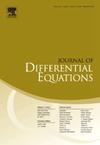Global dynamics of a degenerate reaction-diffusion model for Brucellosis transmission
IF 2.4
2区 数学
Q1 MATHEMATICS
引用次数: 0
Abstract
The effective control of brucellosis is critically important for global public health and the economy. This paper presents a novel degenerate reaction-diffusion model for brucellosis, incorporating spatiotemporal heterogeneity, human behavior dynamics and a multi-stage latent period. The well-posedness of the model is rigorously analyzed, and the basic reproduction number is derived via the next-generation operator method. A threshold result based on the is established: global asymptotic stability of the disease-free equilibrium is proven for , while disease persistence is rigorously demonstrated for . The global asymptotic stability of the disease-free equilibrium for is further proven under spatial heterogeneity. Furthermore, the global attractiveness of the endemic equilibrium under spatiotemporal homogeneity is established through the construction of a Lyapunov function. Numerical simulations identify critical drivers of brucellosis transmission, including human behavior adaptation, latent period staging, and grazing intensity, providing significant insights for brucellosis control strategies.
布鲁氏菌病传播的退化反应扩散模型的全球动力学
有效控制布鲁氏菌病对全球公共卫生和经济至关重要。本文提出了一种新的布鲁氏菌病退化反应扩散模型,该模型结合了时空异质性、人类行为动力学和多阶段潜伏期。对模型的适定性进行了严格的分析,并采用新一代算子法推导了基本再现数R0。建立了基于R0的阈值结果:证明了R0>;1的无病平衡的全局渐近稳定性,并严格证明了R0>;1的疾病持续性。进一步证明了R0=1时无病平衡点在空间异质性下的全局渐近稳定性。此外,通过构造李雅普诺夫函数,建立了时空同质性条件下地方性均衡的全球吸引力。数值模拟确定了布鲁氏菌病传播的关键驱动因素,包括人类行为适应、潜伏期分期和放牧强度,为布鲁氏菌病控制策略提供了重要见解。
本文章由计算机程序翻译,如有差异,请以英文原文为准。
求助全文
约1分钟内获得全文
求助全文
来源期刊
CiteScore
4.40
自引率
8.30%
发文量
543
审稿时长
9 months
期刊介绍:
The Journal of Differential Equations is concerned with the theory and the application of differential equations. The articles published are addressed not only to mathematicians but also to those engineers, physicists, and other scientists for whom differential equations are valuable research tools.
Research Areas Include:
• Mathematical control theory
• Ordinary differential equations
• Partial differential equations
• Stochastic differential equations
• Topological dynamics
• Related topics

 求助内容:
求助内容: 应助结果提醒方式:
应助结果提醒方式:


